Affiliate Disclaimer:
FishKeepingAnswers.com is reader-supported. When you buy through links on our site we may earn a commission.
‘Nano Fish’ has become the colloquial term for smaller fish in the hobby. Keeping smaller tanks has become extremely popular in recent years. 10 gallon, 5 gallon, and even smaller aquariums can be both challenging to create and enjoyable to watch.
15 Nano Fish Ideas
- Celestial Pearl Danio
- Chili Rasbora
- Pygmy Corydoras
- Kuhli Locah
- Green Neon Tetra
- Clown Killifish
- Ember Tetra
- Otocinlus
- Spotted Blue Eyed Rainbow Fish
- Borneo Sucker Loach
- Harlequin Rasbora
- Norman Lampeyed Killifish
- Guppies
- Sparkling Gourami
- White Cloud Mountain Minnow
Celestial Pearl Danio
Celestial Pearl Danios, have become really popular over the last 10 to 15 years. They are small fish with slender bodies. They will grow to a maximum size of about 1 inch.
Celestial Pearl Danios, which are sometimes referred to as Galaxy Rasboras, are schooling fish and as such should be kept in groups of 6 or more. They can be expensive, so care should be taken to make sure their tank is set up and established before adding them.
A 5 gallon or larger tank is really a minimum requirement. They aren’t too fussy on water parameters and they can be kept in cooler water, meaning an unheated tank could be an option.
Celestial Pearl Danios are shy and like to be kept in a well-planted aquarium with slightly lower light levels. Make them feel secure otherwise, they will just hide away the whole time.
These Danios have been known to breed within the home aquarium, but it isn’t a common occurrence. If they do spawn, they may eat their own eggs or fry long before you notice any spawning has taken place.
Feeding Celestial Pearl Danios can be tricky. They only eat in the mid-water column. They won’t feed from the surface or off the bottom so you may need to pair them with a suitable clean-up crew.
I have found live or frozen cyclops, daphnia, and brine shrimp to be the best solution. Any food which stays moving around in the column will probably be eaten.
Celestial Pearl Danios have become a firm favorite both in nano and larger tanks.

Chili Rasbora
The Chili Rasbora, also called the Brigittae Rasbora, is an amazing fire red fish that reaches around 1 inch in length. They do best when kept in groups and the larger the group the better they look. Buy a group of 10 or more and you won’t regret it.
Chili Rasboras school tightly and their bright red coloration looks amazing against a green planted tank. Bear in mind, when you see them in the store and they are young, they don’t look very impressive at all but believe me, they are worth taking home. Give them a few months and you will not be disappointed.
These fish aren’t picky about water parameters, but feeding can be an issue. Chili Rasboras have really small mouths. You’ll need to feed them frozen cyclops, daphnia, or baby brine. They will also relish newly hatched baby brine shrimp. Variety is the key to getting their bright colors to pop.
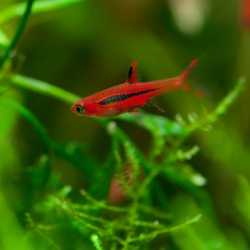
Pygmy Corydoras
Pygmy corydoras are micro versions of their larger cousins which can be found in almost every community tank in the land. Pygmy corydoras will max out at about three-quarters of an inch. They live at the bottom of your nano tank and they make the perfect clean-up crew for some of the other nano species listed here.
Pygmy corydoras aren’t fussy eaters. They will swim around the substrate hoovering up any food that makes it to the bottom. They particularly enjoy micro pellets, wafers, and Repashy foods. As for schooling fish, they should really be kept in groups of 6 or more.
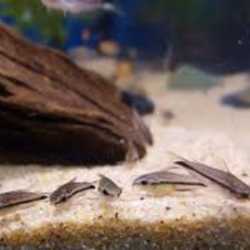
Kuhli Loach
Khuli loach aren’t often considered nano fish because they will grow to 3 or 4 inches. However, they are slender and spend most of their days tucked up either under plants or in decorations.
The reason we like to use them in nano tanks is they come out at night and clean up all the leftover food. They will consume just about anything that is left after the lights go out.
Kuhli loach are super peaceful and won’t pose a threat to any of your other nano inhabitants. In fact, they do better with small fish than larger ones. Kuhli loaches aren’t fussy on water parameters either. They are extremely hardy fish and people have been known to keep them alive for 10 or more years.
Kuhli loach have various color forms including orange and blacked banded variety as well as black or silver forms. They make a great addition to any tank.
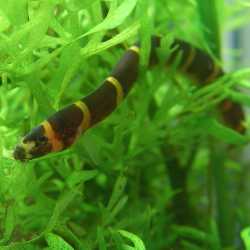
Green Neon Tetra
Green neon tetras are the smaller cousins of the ever-popular Neon Tetras. It’s unusual to get green in the fish-keeping hobby. This little gem boasts fantastic color, especially when viewed from above.
Much like the species mentioned above, green neon tetras are mid-water schooling fish that want to eat in the middle of the water column. They don’t want to eat from the surface or the substrate.
I’ve found they do great on baby brine shrimp, cyclops, and daphnia just like other species of nano fish. If you don’t have a brine shrimp hatchery, I use THIS ONE from Amazon. It’s simple to use and produces a really high hatch rate.
Green neon tetras will school, although not as tightly as other species. Again, go for 6 or more. These tetras are usually wild-caught, so take the time to quarantine them and deworm them at least once.
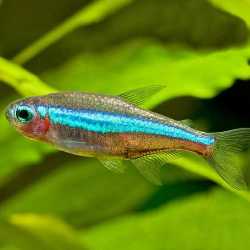
Clown Killifish
Clown killifish are often called the Rocket Killifish, and if you have ever seen one in person you will know why.
They are black and yellow and they have a red streak on the tail fin which looks like fire from a rocket. Females are less colorful than males, but to get the best color from your males, you will want to keep both sexes.
Clown Killifish spend all of their time swimming around in the top third of your tank. Be warned, they will jump at a moment’s notice.
Any gap in the lid and they will find a way through it. As they spend so much time near the top of the tank, they will happily eat off the surface. I have found they will readily take freeze-dried blood forms, floating micro pellets, or flake food.
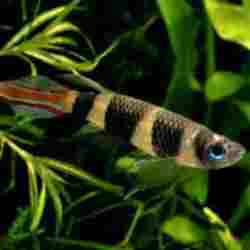
Ember Tetras
I genuinely believe every tank should have a group of Ember tetras in it. These super bright red fish reach around 1 and 1/4 inches long.
They have a little more personality than other nano species on the list and they are certainly more outgoing. Ember tetras are hardy and not too fussy on water parameters. I’ve had a group in a 40-gallon tank for around 3 years and they are still going strong.
Ember tetras do primarily want to eat mid-water, but they will venture both to the surface and the bottom of the tank. My Embers eat flake food, micro pellets, and frozen cyclops.
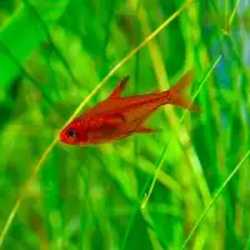
Otocinclus
Otocinclus aren’t colorful or showy, and they don’t really have personality. So why would you want one in a nano tank? What Otocinclus do, possibly better than any other species of fish, is eat algae. Specifically, brown, diatom algae.
If you are setting up a new tank, keeping an Otto or two on hand is a must. Once your new tank starts to go through the brown algae stage, add the Otto’s and let them get to work. They will clear the tank of brown algae in no time.
Otocinclus prefer a planted tank where they will spend day and night attached to leaves, rocks, or the tank sides, munching their way through algae. Once all the algae is gone, Otocinclus can be tricky to feed, so I recommend having another tank to move them to. A larger tank will naturally have more algae to keep the Otocinclus fed.
Otocinclus are compatible with any fish, providing they won’t be seen as prey. Most community fish work well with Otocinclus.
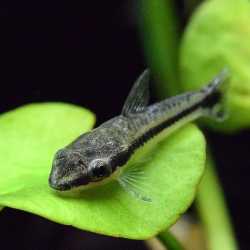
Spotted Blue Eyed Rainbow Fish
The Spotted Blue Eye Rainbow, or Gertrudae Rainbowfish as it is sometimes known, only grows to around 1 and 1/2 inches long. They swim all over the tank, although they prefer that mid-water section. In a nano setup, a male and two females make a great trio.
Be aware the males look better than the females, but you need both sexes for the males to really show their colors. Males will flare their fins and ‘dance’ for the females.
Spotted Blue Eye Rainbowfish look at their best when kept in a planted tank. They are not too fussy about water temperatures, but they do prefer a higher pH and slightly harder water. These colorful little fish will readily breed in the home aquarium, although they may well eat their eggs and fry before you get a chance to see them.
Spotted Blue eyes only live for 2 to 3 years and they are great jumpers, so keep your tank well covered.
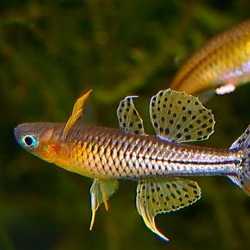
Borneo Sucker Loach
Borneo Sucker loaches are super hardy algae eaters that can be kept either alone or in groups. They are totally plant safe and spend their whole lives glued to any surface that might have algae growing on them.
Borneo Sucker Loaches are smaller versions of Reticulated Hillstream Loaches. They only reach around 1 to 1 and 1/2 inches. They are super peaceful and make a great addition to your tank.
Harlequin Rasbora
The Harlequin Rasbora has been a firm favorite in the aquarium hobby for over 100 years. It was one of the first I ever kept. Although not often thought of as a nano fish, 5 Harlequins in a 10-gallon tank looks superb.
Harlequins will happily move around the whole tank, taking advantage of the cover provided by plants. They reach up to 2 inches long and are very undemanding in their care needs. Feed them a varied diet that includes some live or frozen foods and they will reward you with deep red and bright orange coloration.
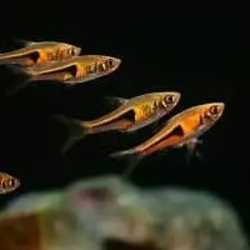
Norman Lampeye Killifish
Norman Lampeye Killifish have the most amazing blue eye you will ever see in a fish. Videos and photographs just don’t do them justice. See them in the flesh and you’ll want some!
These Killifish are schooling by nature. In the wild, they swim in groups numbering a thousand or more. Buy a group of at least 6 and remember, the more you have, the tighter they will school.
A school of 6 in a 20-gallon tank which is planted around the edges, but open in the middle will be a really enjoyable tank. Lampeye Killifish look best against a dark substrate and they prefer subdued lighting.
When it comes to feeding, I’ve found meaty foods such as bloodworm, daphnia, and cyclops have been relished. Norman Lampeyes are relatively easy to breed, although trying to do so in a nano tank is optimistic.
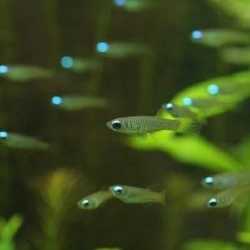
Guppies
Although I wouldn’t keep male and female guppies in a nano tank because they will quickly multiply and overrun the tank, a group of 4 or 5 males in a ten-gallon tank can look spectacular. Guppies will inhabit all areas of the tank, feeding on the surface, mid-water, and bottom.
Guppies are undemanding and extremely hardy. Male guppies come in just about every color you can imagine. Whether you go for 4 all of the same color, or each one being different, you won’t be disappointed.
Guppies will eat just about any fish food you choose to feed them. Flakes, mini-pellets, live and frozen foods will all be eating the moment they hit the water.
Male guppies grow to around 2 inches and will accept a very wide range of water parameters. Guppies are not too fussy about water temperature providing the temperature doesn’t drop too far into the low 70’s. Guppies are hardy and would make a great choice of fish for your first nano setup.

Sparkling Gourami
If guppies make a great fish for those setting up their first nano tank, Sparkling Gouramis are definitely for those with a few tanks under their belt. Sparkling Gouramis, also known as the Pygmy Gourami, grow to around 1 and 1/2 inches and a pair would be at home in a well-planted, dimly lit 10-gallon tank.
These tiny gouramis will want to feed on the surface, so floating food like a flake or mini pellets will be taken. They will also eat live or frozen food which stays in the water column, such as cyclops or baby brine shrimp.
Sparkling gouramis are excellent jumpers, so never leave your tank uncovered.
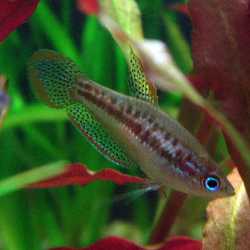
White Cloud Mountain Minnows
White cloud mountain minnows are really underappreciated in the fish-keeping hobby. They are often seen as ‘beginner fish’. They have a hardy nature and are undemanding in almost every aspect of their care.
White clouds are slim fish and their coloration ranges from silvery blue to golden. They will tolerate a massive temperature range and will quite happily live in an unheated aquarium. White clouds will eat almost any food you give them and they will probably even breed in your 10-gallon nano tank.
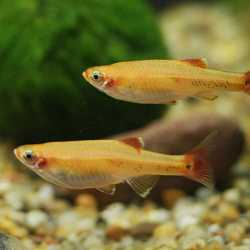
In Conclusion
Nano tanks are really in fashion at the moment. The internet is littered with photographs of tanks from 2 gallons upwards. No matter how large or small your home, there will be a space you can fit a nano tank. They should however come with a health warning. Nano tanks are seriously addictive!
Nano fish are some of the most colorful freshwater fish in the hobby. Make space for a nano tank and you won’t regret it.







